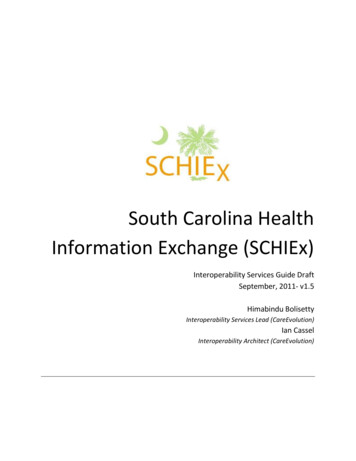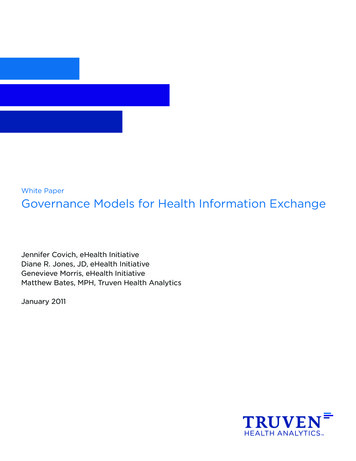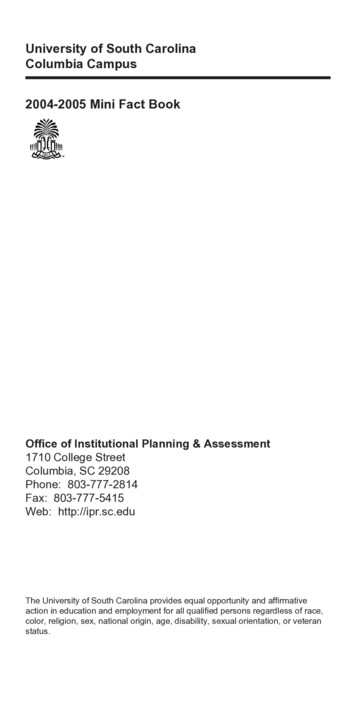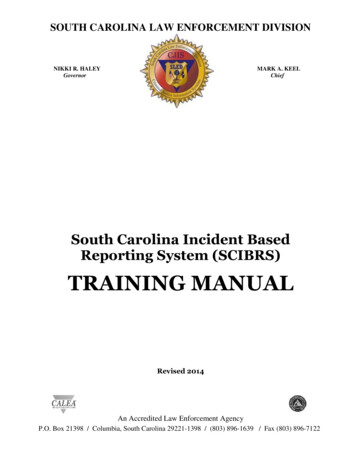
Transcription
South Carolina HealthInformation Exchange (SCHIEx)Interoperability Services Guide DraftSeptember, 2011- v1.5Himabindu BolisettyInteroperability Services Lead (CareEvolution)Ian CasselInteroperability Architect (CareEvolution)
SCHIEx Interoperability Services Guide v1.5Table of ContentsIntroduction . 4Objective . 4Intended Audience . 4On-boarding Considerations: . 4Background . 5Guiding Principles . 6SCHIEx Technology Overview. 7A Brief Overview of NwHIN Standards and IHE . 9Integrating the Healthcare Enterprise (IHE) . 9Clinical Document Architecture . 10Continuity of Care Document . 10HITSP CDA Content Modules (C83) . 10HITSP C32 . 10IHE PCC . 11What it means to “Connect to SCHIEx” . 11Resources Provided by the SCHIEx to Participants . 11SCHIEx PIX Management Service . 12SCHIEx XDS.b Document Registry . 12Audit Services. 12Consent Services . 12Exchange with the Public Health Immunization Registry: SCDHEC Immunization Registry Reporting andRetrieval Services . 13A Step-by-Step Overview of SCHIEx Data Flow . 13Step 1 – Provide Patient Information . 14Step 2 – Provide Documents . 14Step 3 – Retrieve Documents. 15SCHIEx IHE Participation Part I. Architecture . 16Page 2
SCHIEx Interoperability Services Guide v1.5Overview: Connecting to SCHIEx . 16SCHIEx IHE Participation Part II: Sending Content . 18Content Validation and Testing Process . 18Getting Connected- Process Flow . 20Preparation: . 20Step 1: Register in the SCHIEx Website and submit the signed SCHIEx Legal Agreements andAssociated Business Documents. . 20Step 2: Complete Basic Content and Interface Validation and submit the SCHIEx Participant TechnicalTest Credentialing Application . 20Step 3: Complete Technical Verification and Validation . 21Step 4: Complete the SCHIEx Online Subscription and Order Form . 21Step 5: Receive your Production Technical Package . 21Technical Preparation Checklist . 21Test 1 – Provide Patient Information . 21Test 2 – Obtain SCHIEx Affinity Domain Patient Identifier . 22Test 3 – Register Document with Registry . 22Test 4 – Query Registry by Patient Identifier . 23Test 5 – Retrieve document from Repository (as Repository actor) . 23Test 6 – Query Registry for On-demand documents associated with patient. 23Additional Resources and References . 24PIX and XDS.b and BPPC Profiles. 24IHE Patient Care Coordination (PCC) Profiles or Content profiles . 24http://www.ihe.net/Technical Framework/upload/IHE PCC Suppl Immunization Content Rev22 TI 2011-09-09.pdf . 24HITSP C32 . 24Wiki Pages . 25Annotated XDS Examples . 25Page 3
SCHIEx Interoperability Services Guide v1.5IntroductionObjectiveThis document provides a technical overview of the South Carolina Heath Information Exchange(SCHIEx) and the standards-based specifications regarding connectivity to SCHIEx. First, this guide isintended to serve as an introduction to the technical services, implementation methodology andnational standards that have been employed to develop SCHIEx into a highly secure and standardsbased platform that will serve as the backbone for health information exchange in the state of SouthCarolina. Second, this guide will detail the national standards and technical requirements that must beimplemented by Exchange Participants. The step-by-step “on-boarding” process that will enable yourorganization to connect to SCHIEx is discussed in detail.Intended AudienceThis document is intended for prospective SCHIEx Participants who are seeking an introduction to thetechnical services provided by SCHIEx and an outline of the work process required to take part in theExchange. It is intended for technical users familiar with health care information technology standardssuch as those promulgated by HITSP (Healthcare Information Technology Standards Panel), ONC (Officeof the National Coordinator), and IHE (Integrating the Healthcare Enterprise).On-boarding to SCHIEx implies that your organization can securely exchange clinical information onpatient with other healthcare organizations that are also part of the exchange. Please ensure that youhave the right stakeholder group engaged in evaluating and making decisions around the On-boardingConsiderations listed below.On-boarding Considerations: What are your high level goals in connecting to the exchange?What kind of clinical information do you want to make available via the exchange and when do youwant to publish this information - for e.g. you might decide to publish an encounter summarydocument, containing problems, medications, allergies and results formatted as a HITSP C32 at thetime of patient discharge or as a PCP, you may decide to publish a referral summary, containing areason for referral, history of present illness, active problems etc., for a patient that requires followup by a specialistWhat steps must be taken to designate any information requiring special protection underapplicable laws as such in your electronic medical record system and, if necessary, to withholdsuch information from SCHIEx.Do you plan to utilize the SCHIEx platform for Public Health Reporting?What kind of clinical information are you interested in receiving from the exchange and how do youplan on making that part of your current workflow so the clinician is presented with the rightinformation at the right time CareEvolution, Inc.Page 4
SCHIEx Interoperability Services Guide v1.5 What systems do you want to use in order to on-board to the exchange and do they have thecapabilities required for on-boarding?Do you have the capability to host your document sharing repository or do you plan to utilize a thirdparty hosting solution?BackgroundSouth Carolina is in the forefront of health information technology (HIT) with both public and privateinitiatives in support of HIT even before the American Recovery and Reinvestment Act of 2009 (ARRA)and incentive funding. Launched in 2007, SCHIEx is an innovative statewide initiative that provides astate-level information highway that connects healthcare providers and stakeholder groups to eachother across South Carolina. Originally seeded with claims data, SCHIEx was built on a federatedarchitecture that delivers a 10-year health history of more than 4.3 million South Carolina citizensinferred from Medicaid and UB92/HCFA1500 claims. This broad dataset, which covers all of SouthCarolina, is now being supplemented by deep clinical data from prescription history sources, SouthCarolina’s immunization registry, and local and regional EMR-enabled healthcare providers.SCHIEx provides core HIE network services such as a statewide master patient index (MPI), a statewiderecord locator service (RLS), authentication services, and audit services that can be leveraged byparticipants of the exchange. . Figure 1 illustrates the services of SCHIEx. CareEvolution, Inc.Page 5
SCHIEx Interoperability Services Guide v1.5SCHIEx ServicesData Resources via SCHIExCore Network Services and ApplicationsRecord Locator ServiceMaster Patient IndexMedicaid ClaimsClinical ViewerUB92/04TerminologyRx HistoryAudit/LogImmunizationsSecurity (TLS, PKI/Certificate Authentication)Hospitals & CommunityHealth CentersClinicsProvidersRegional HealthInformationExchangeFigure 1 - SCHIEx OverviewGuiding PrinciplesSCHIEx has been developed in a multi-year effort with close collaboration between a diverse set ofstakeholders in the state of South Carolina and in concert with nationally recognized standards andpolicies set forth by the Office of the National Coordinator for Health Information Technology. Thefollowing guiding principles have been established to ensure the development of an effective technologyplatform to serve the needs of South Carolina: SCHIEx is built on open technology standards for health information exchange andinteroperability. Eligible South Carolina organizations that wish to participate in SCHIEx canimplement the necessary interfaces by selecting from a wide range of health informationtechnology vendors with electronic health record systems that will have been certified tocomply with nationally established standards. SCHIEx is highly secure and committed to patient privacy. Every aspect of the healthinformation exchange process is secured in order to protect private patient health information.SCHIEx Participants are required to implement a PKI certificate-based encryption scheme thatprotects patient information in transport and authenticates Exchange Participants. All centrallylocated demographic information is secured using an industry leading crypto-hash persistence CareEvolution, Inc.Page 6
SCHIEx Interoperability Services Guide v1.5mechanism that guarantees sensitive demographic information cannot be revealed through thenetwork. SCHIEX is designed as federated information architecture. SCHIEx minimizes the amount ofinformation that will be managed centrally. Clinical data is persisted in Participant managedrepositories and will be available to other SCHIEx Participants only when a verifiable clinicalrelationship has been established with the relevant patient. SCHIEx focuses on delivering highly valuable health data to providers. SCHIEx has alreadyimplemented interfaces to a wide array of state-level health data assets such as Medicaid andUB92/04 claims information, so that new Participants can potentially have access to clinical datafor a large set of their patients – avoiding the “Empty HIE” problem.SCHIEx Technology OverviewSCHIEx is built using open technology standards that fully comply with the specifications established bythe Nationwide Health Information Network (NwHIN). NwHIN is a set of standards, services, andpolicies that enable secure health information exchange over the Internet. The NwHIN will provide afoundation for the exchange of health IT across diverse entities, within communities, and across thecountry.SCHIEx is modeled after the Markle Foundation’s Connecting for Health Framework and implements a“network of networks” approach for health information exchange across South Carolina. SCHIEx is builton a commercial off-the-shelf software (COTS) technology stack that uses a federated, service-orientedarchitecture (SOA) to deliver a standards-compliant enterprise service bus to deploy and operate astatewide HIE.Key items of note in this architecture are its flexibility and compliance with NwHIN and HITECH/ARRAMeaningful Use Final Rule standards:oSCHIEx is designed as a federated model where the edge systems adapters are physically locatedadjacent to the source.oSCHIEx provides a statewide Master Patient Index (MPI) service.oSCHIEx also implements a Record Locator Service (RLS) which serves as a “white pages” for thestate providing pointers to clinical information about a given patient.oSCHIEx provides the Service Access Layer which provides a trusted uniform transport andsecurity infrastructure based on web services following NwHIN standards. These standards (i.e.IHE ATNA) describe the security environment (user identification, authentication, authorization, CareEvolution, Inc.Page 7
SCHIEx Interoperability Services Guide v1.5and access control), audit requirements, and transport-level requirements (TLS) to ensure eachnetwork node complies with the guiding principles of SCHIEx for security and privacy.oSCHIEx provides a Clinical Viewer web application. It is specifically designed to providevisualization and data monitoring tools that are tailored to the wealth of claims data available tothe Exchange, in order to drive provider productivity and improved patient care outcomes.Figure 2 shows SCHIEx Services and the standards used for interoperability for healthcare providersto connect. It demonstrates compliance with national interoperability standards to facilitateconnecting to the NwHIN and other states. Similarly the Healthcare Information TechnologyStandards Panel (HITSP)/ integrating the Healthcare Enterprise (IHE) compliant standards (PatientIdentifier Cross Reference (PIX)/Physician Data Query (PDQ), Cross Enterprise Document Sharing(XDS.b)/CCD allows providers from disparate and diverse healthcare settings to connect to SCHIEx.Figure 2: SCHIEx Services and Standards-based Interoperability CareEvolution, Inc.Page 8
SCHIEx Interoperability Services Guide v1.5A Brief Overview of NwHIN Standards and IHEA basic understanding of the standards, services and policies mandated by the NwHIN is necessary tounderstand the technical requirements specified for every SCHIEx Participant. An introduction to thecore standards is provided in this section. Detailed documents describing these standards are availableat:NwHIN History and /community/healthit hhs gov nhin historical backgroundinformation/1409Integrating the Healthcare Enterprise: IT Infrastructure Technical Frameworkhttp://www.ihe.net/Technical Framework/index.cfm#ITHITSP Harmonization omponentsIntegrating the Healthcare Enterprise (IHE)IHE is an industry-leading initiative that seeks to facilitate the exchange of information amonghealthcare systems by creating detailed specifications for specific use cases that optimize establishedstandards.IHE has published a set of “Integration Profiles” (an amalgamation of existing standards andsupplemental usage constraints designed for a specific use case) that define the core interoperabilityservices implemented by SCHIEx. Specifically, the following integration profiles must be understood andimplemented by participating organizations:1.2.3.4.5.PIX: Patient Identifier Cross ReferenceXDS.b: Cross Enterprise Document SharingATNA: Audit Trail and Node AuthenticationCT: Consistent TimeBPPC: Basic Patient Privacy and Consent (see the Consent Services section)IHE also tests and certifies compliance with these integration profiles at carefully planned andsupervised events called Connectathons. SCHIEx core network service technologies have been certifiedwith regards to the relevant integration profiles. It is recommended that participating organizationsselect information technology vendors that have also been certified at a recent IHE Connectathon.While the majority of this document focuses on the transport, handshake, and mechanism of exchange,the actual “content” of what health information may be exchanged from a technology standpoint isgoverned by the following industry standards: CareEvolution, Inc.Page 9
SCHIEx Interoperability Services Guide v1.5Clinical Document ArchitectureClinical Document Architecture (CDA) is an HL7 document markup standard that specifies the structureand semantics of "clinical documents" for the purpose of exchange. CDA documents derive theirmachine-processable meaning from the HL7 Reference Information Model (RIM) and use the HL7Version 3 Data Types. CDA is flexible XML-based clinical document architecture. CDA itself is not aspecific document, but can be used to express many types of documents.A CDA document can contain many data sections, all of which contain narrative text, and some of whichcontain structured data elements, some of which are coded. There are many types of CDA documents,including CCD, XDS-MS Discharge Summary (HITSP C48), History and Physical (HITSP C84), Lab Report(HITSPC37), etc.Continuity of Care DocumentContinuity of Care Document (CCD) describes constraints on the HL7 Clinical Document Architecture,Release 2 (CDA) specification. It specifies a core data set of the most relevant administrative,demographic, and clinical information facts about a patient’s healthcare, covering one or morehealthcare encounters. It provides a means for one healthcare practitioner, system, or setting toaggregate all of the pertinent data about a patient and forward it to another practitioner, system, orsetting to support the continuity of care.CCD is just one type of CDA document. Other types of CDA documents can contain some of the sameCCD sections, but different sections as well.HITSP CDA Content Modules (C83)HITSP CDA Content Modules (C83) describes a library of sections that can be combined into various CDAdocument types. In addition, a document type can include additional sections, even those not a part ofit. So for example a CCD could add a Reason for Referral section added and still be a valid CCD. Inaddition, the sections in C83 can contain structured data, described as "Entry Content Modules" that arebeing assembled into a "HITSP Data Dictionary" that describes the data elements and the constraints(optionality, repeatability, and value sets) for each data elementHITSP C32HITSP C32, The HITSP Summary Document Using HL7 Continuity of Care Document (CCD) Componentdescribes the document content summarizing a patient's medical status for the purpose of informationexchange. The content may include administrative (e.g., registration, demographics, insurance, etc.) andclinical (e.g., problem list, medication list, allergies, test results, etc.) information. Any specific use of thisComponent by another HITSP specification may constrain the content further based upon therequirements and context of the document exchange. This specification defines content in order topromote interoperability between participating systems. Any given system creating or consuming thedocument may contain much more information than conveyed by this specification. Such systems mayinclude Personal Health Records (PHRs), EHRs (Electronic Health Records), Practice ManagementApplications and other persons and systems as identified and permitted. CareEvolution, Inc.Page10
SCHIEx Interoperability Services Guide v1.5IHE PCCIHE Patient Care Coordination (PCC) domain was established in July 2005 to deal with integration issuesthat cross providers, patient problems or time. It deals with general clinical care aspects such asdocument exchange, order processing, and coordination with other specialty domains. PCC alsoaddresses workflows that are common to multiple specialty areas and the integration needs of specialtyareas that do not have a separate domain within IHE.IHE PCC Profiles include document types like Medical Summary (MS), Emergency Department Referral(EDR), Exchange of Personal Health Record Content (XPHR), Immunization Content (IC) etc. that formthe initial set of documents accepted by the SCHIEx registry.What it means to “Connect to SCHIEx”Connecting to SCHIEx means that your organization will be able to send and receive health informationamongst other SCHIEx Participants that have been “on ramped” to SCHIEx by leveraging the MPI, RLS,and core network services offered by SCHIEx.Participants must agree to abide by all policies and procedures that govern the operation of SCHIEx (seewww.SCHIEx.org for detailed policy documents).In order to connect to SCHIEx, the health information systems in your organization will need toimplement the technical services and interfaces described in the “Step-by-Step Overview of SCHIEx DataFlow” section below. In addition, your organization will need to follow the process steps outlined in“Getting Connected- Process Flow” in order to demonstrate standards-based exchange capabilities andobtain your credentials and connectivity information.Resources Provided by the SCHIEx to ParticipantsSCHIEx implements a set of IHE and NwHIN standards compliant services to facilitate the flow of clinicaldata between Participants. These network-level services are intended to support the federatedmanagement of clinical data by providing secure patient identity management and record location for allpatients in the state of South Carolina.XDS.b RepositorySCHIEx PIX ManagerXDS.b RepositoryXDS.b RepositoryClinical Data Repositoriesfrom Other Sites CareEvolution, Inc.SCHIEx XDS.b RegistrySCHIEx ServicesPage11ImmunizationRegistryRX HistoryData Sourcesavailable via SCHIEx
SCHIEx Interoperability Services Guide v1.5SCHIEx PIX Management ServiceSCHIEx provides statewide PIX Management service that provides identity management services toSCHIEx Participants. Participants will send demographic information for the patients that they manageto the SCHIEx PIX Manager which implements a robust record linking algorithm to link together patientrecords across the state.The SCHIEx PIX Management Service implements the PIX (Patient Identifier Cross-Referencing) IHEintegration profile.SCHIEx XDS.b Document RegistrySCHIEx provides a statewide XDS.b Document Registry that provides record location services for allclinical data available through SCHIEx. Participants will register metadata describing the clinicaldocuments that they are making available through their XDS.b Repositories so that other sites can easilyobtain a catalog of all clinical data and its managing repository for a particular patient.The SCHIEx Document Registry implements the XDS.b (Cross Enterprise Document Sharing-b) IHEintegration profile.As part of the SCHIEx connectivity testing, participants will be provided guidance on certain metadatavalues like the PIX namespace to use, Repository id (to avoid conflicts across participants), Source id etc.A root OID will be provided for the source ID and the Participant must ensure that each facility, withintheir organization, that is connecting to SCHIEx is assigned a different source ID based on the root OIDthat is provided.Audit ServicesSCHIEx captures audit data for identity management and its core clinical data services. SCHIEx does notprovide a centralized store of audit information for clinical data that is managed in locally implementedXDS.b repositories. Participants that are managing these locally implemented repositories are requiredto implement appropriate audit services as described by the IHE ATNA Secure Node Integration Profile.Consent ServicesIHE BPPC (Basic Patient Privacy Consent) profile is used to record and communicate patient optout/cancel opt out preferences. Opt-out and cancel opt-out preferences are global, triggering a systemwide implementation of the patient’s desired status. Participants can choose to send the BPPCdocument with or without a scanned document part. Note that the “formatCode” is required to beurn:ihe:iti:bppc:2007 and this is the same as what is required by the IHE standards.Details of BPPC and content requirements are currently addressed by ITI-TF Volume 1 and Volume 3. Asof April 2011, there is a change proposal that addresses the issue of where to indicate the privacy policybeing acknowledged by the patient. CareEvolution, Inc.Page12
SCHIEx Interoperability Services Guide v1.5The code element of the Patient Privacy Acknowledgement Service Event should be present and theexpected code attribute values are as follows:Opt-out OID: 1.3.6.1.4.1.37619.2.1Cancel Opt-out: OID: 1.3.6.1.4.1.37619.2.2In the code element, the codeSystem attribute should be set to “1.3.6.1.4.1.37619” and thecodeSystemName should be “SCHIEx”The documentationOf/serviceEvent/effectiveTime element’s low value is taken into consideration whenpatient opt status changes are being effected on the SCHIEx network. The effectiveTime/low value hasto be before the time the document is published to the repository. The effectiveTime/high element isignored. If the patient chooses to reverse opt decision after a certain point in time, then a separate BPPCwith the right opt status is required to be registered.Exchange with the Public Health Immunization Registry: SCDHECImmunization Registry Reporting and Retrieval ServicesIf you are an organization that is interested in having immunization administration information fromyour organization flow through to the SC Immunization Registry (DHEC) with SCHIEx as a gateway, youhave that option available to you. This service enables you to leverage your connectivity to SCHIEx toalso satisfy the needs to reporting to the Immunization registry.In order for dataflow to be functional, you will need to create and register a NIST compliant stableImmunization Content document (IHE PCC) or a NIST compliant stable HITSP C32 with the Immunizationsection populated with CVX or CPT coded immunization records. This will be tested for, in depth, in“Step 3: Complete Verification and Validation” of the on-boarding process if the participant chooses toleverage this functionality. You can also request to test this as part of step 1 if you are interested infinding and fixing any issues that might arise. Please contact your SCHIEx technical resource to indicateyour preferences.Note that connecting to SCHIEx also allows you to retrieve the Immunization history on a patient. Thehistory is available as an on-demand Immunization Content document that is registered with the SCHIExregistry, if a patient match can be made within the Immunization R
South Carolina Health Information Exchange (SCHIEx) Interoperability Services Guide Draft September, 2011- v1.5 . network of networks _ approach for health information exchange across South Carolina. SCHIEx is built on a commercial off-the-shelf software (COTS) technology stack that uses a federated, service-oriented .










